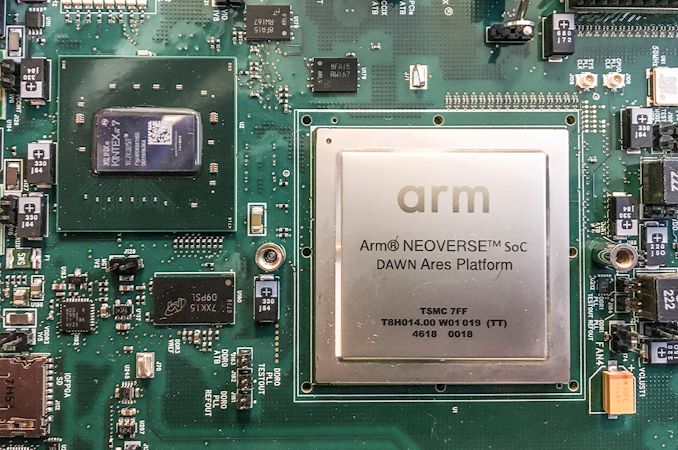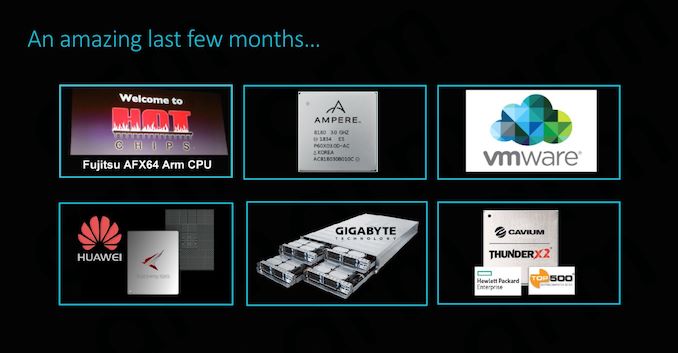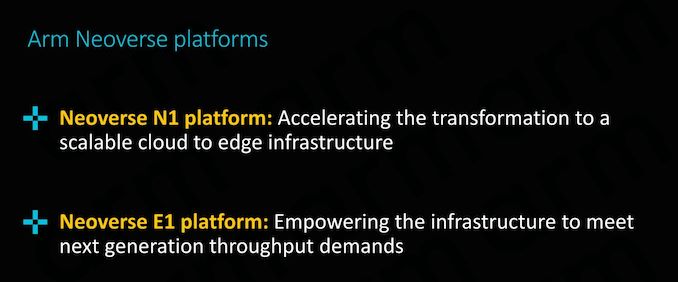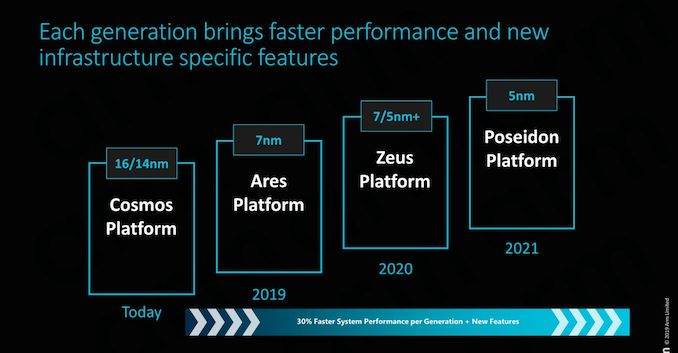Arm Announces Neoverse N1 & E1 Platforms & CPUs: Enabling A Huge Jump In Infrastructure Performance
by Andrei Frumusanu on February 20, 2019 9:00 AM EST
Anybody following the industry over the last decade will have heard of Arm. We best know the company for being the enabler and providing the architecture as well as CPU designs that power essentially all of today’s mobile devices. The last 7-5 years in particular we’ve seen meteoric advances in silicon performance of the mobile SoCs found in our smartphones and tablets.
However Arm's ambition goes widely beyond just mobile and embedded devices. The market for compute in general is a lot larger than that, and looking at things in a business sense, high-end devices like servers and related infrastructure carry far greater profit margins. So for a successful CPU designer like Arm who is still on the rise, it's a very lucrative market to aim for, as current leader Intel can profess.
To that end, while Arm has been wildly successful in mobile and embedded, anything requiring more performance has to date been out of reach or has come with significant drawbacks. Over the last decade we’ve heard of numerous prophecies how products based on the architecture will take the server and infrastructure market by storm “any moment now”. In the last couple of years in particular we’ve seen various vendors attempt to bring this goal to fruition: Unfortunately, the results of the first generation of products were less than successful, and as such, even though some did better than others, the Arm server ecosystem has seen a quite a bit of hardship in its first years.
A New Focus On Performance
While Arm has been successful in mobile for quite some time, the overall performance of their designs has often left something to be desired. As a result, the company has been undertaking a new focus on performance that is spanning everything from mobile to servers. Working towards this goal, 2018 was an important year for Arm as the company had introduced its brand-new Cortex A76 microarchitecture design: Representing a clean-sheet endeavor, learning from the experience gained in previous generations, the company has put high hopes in the brand-new Austin-family of microarchitectures. In fact, Arm is so confident on its upcoming designs that the company has publicly shared its client compute CPU roadmap through 2020 and proclaiming it will take Intel head on in PC laptop space.
While we’ll have to wait a bit longer for products such as the Snapdragon 8CX to come to market, we’ve already had our hands on the first mobile devices with the Cortex A76, and very much independently verified all of Arm’s performance and efficiency claims.
And then of course, there's Neoverse, the star of today's Arm announcements. With Neoverse Arm is looking to do for servers and infrastructure what it's already doing for its mobile business, by greatly ramping up their performance and improving their competitiveness with a new generation of processor designs. We'll get into Neoverse in much deeper detail in a moment, but in context, it's one piece of a much larger effort for Arm.
All of these new microarchitectures are important to Arm because they represent an inflection point in the market: Performance is now nearing that of the high-end players such as Intel and AMD, and Arm is confident in its ability to sustain significant annual improvements of 25-30% - vastly exceeding the rate at which the incumbent vendors are able to iterate.
The Server Inflection Point: An Eventful Last Few Months Indeed
The last couple of months have been quite exciting for the Arm server ecosystem. At last year’s Hotchips we’ve covered Fujitsu’s session of their brand-new A64FX HPC (High performance compute) processor, representing not only the company shift from SPARC to ARMv8, but also delivering the first chip to implement the new SVE (Scalable Vector Extensions) addition to the Arm architecture.
Cavium’s ThunderX2 saw some very impressive performance leaps, making its new processor among the first to be able to compete with Intel and AMD – with partners such as GIGABYTE offering whole server systems solutions based on the new SoC.
Most recently, we saw Huawei unveiled their new Kunspeng 920 server chip promising to be the industry’s highest performing Arm server CPU.
The big commonality between the above mentioned three products is the fact that each represents individual vendor’s efforts at implementing a custom microarchitecture based on an ARMv8 architectural license. This in fact begs the question: what are Arm’s own plans for the server and infrastructure market? Well for those following closely, today’s coverage of the new Neoverse line-up shouldn’t come as a complete surprise as the company had first announced the branding and road-map back in October.
Introducing the Neoverse N1 & E1 platforms: Enabling the Ecosystem
Today’s announcement is all about enabling the ecosystem; we’ll be covering in more detail two new “platforms” that will be at the core of Arm’s infrastructure strategy for the next few years, the Neoverse N1 and E1 platforms:
Particularly today’s announcement of the Neoverse N1 platform sheds light onto what Arm had teased back in the initial October release, detailing what exactly “Ares” is and how the server/infrastructure counter-part to the Cortex A76 µarchitecture will be bringing major performance boosts to the Arm infrastructure ecosystem.













101 Comments
View All Comments
WinterCharm - Wednesday, February 20, 2019 - link
There's a gigantic Arm vs x86/64 battle brewing for the entire computer industry. ARM is just more efficient at every level, and if software is properly optimized it performs brilliantly.eva02langley - Wednesday, February 20, 2019 - link
However, it doesn't have the raw power required for many fields like scientific, compute and research. The core-count is also a huge factor in the upcoming future and unless you develop a chiplet approach, ARM is going to face the same issue of monolithic chips.The next chiplet evolution will require stacking. The future is way more related to modularity than the chip architecture. Don't get me wrong, the more advancement, the better for everyone, but I don't believe ARM is going to render x86 obsolete, hovwever I believe multi-chips SoC are going to render monolithic chip obsolete in the computer world.
SarahKerrigan - Wednesday, February 20, 2019 - link
Sure it does. There are ARM supercomputers, and this very article shows an N1 core outperforming Zen on single-thread, and both Zen and SKL-SP on throughput.HStewart - Wednesday, February 20, 2019 - link
I think you are forgetting the very nature of RISC (Arm) vs CISC (x86) architectures. By the nature of designed of RISC - reduce instruction set, it takes more instruction to execute same operation than CISC. For simple stuff RISC can likely do better but remember also modern x86 based CPU also break down more complex instructions in simpler instruction so it can run one multiple pipelines.SarahKerrigan - Wednesday, February 20, 2019 - link
Dude, I work in the semi industry, and I've designed pipelined cores. Saying "ARM's workload-demonstrated higher performance doesn't matter because x86 is CISC" is idiotic.SPEC isn't "simple stuff." It is a selection of extremely compute-intensive workstation loads, one that the whole industry - including Intel - uses to demonstrate comparative performance.
HStewart - Wednesday, February 20, 2019 - link
The biggest thing I found that seems misinformation is statement that these are estimates and this chip is simulated which tells me they don't need the real numbers.All I am saying is that CISC instructions can do more than RISC instructions per instruction, and it depends on compiler to take advantage of the those instructions. Please note I never sated it does not matter and that was in your words. I just mention considerations need to take in account of different architextures and the fact they are comparing future simulated designed to last year designs.
Andrei Frumusanu - Wednesday, February 20, 2019 - link
> All I am saying is that CISC instructions can do more than RISC instructions per instructionNobody cares. If the performance per clock is same or higher, you're just arguing about semantics.
Internally CISC processors break things down into RISC like µOps anyway.
ZolaIII - Wednesday, February 20, 2019 - link
@Andrei Frumusanu what would be estimated size of an A55 core with similar amount of cache as on represented E1 on 7nm lithography? I am very curious about that one. Also comparation to the A72 & A73 should be a good thing as ARM clames it reaches their level of performance. Its very interesting first born (SMT) and much needed one.zmatt - Wednesday, February 20, 2019 - link
When people talk about complex instructions they don't mean something like find the derivative of x^2. They mean something like a conditional move operation. The speed advantages on paper between RISC and CISC are in theory a wash. This is because while CISC can conceivably do more in an instruction, RISC can do more instructions per clock generally. In the real world the simplicity of RISC means usually, all other things being equal, the chips are simpler and can run higher clocks, draw less power and generate less heat for a given level of performance.x86 chips haven't actually been CISC since the mid 90's. Both Intel and AMD have been making chips that take the CISC instructions and run them through an instruction decoder that then hands RISC instructions to the actual cpu. Yes this does incur some overhead but it frees up cpu design quite a bit without being so closely tied to backwards compatibility.
The fact that modern x86 chips ultimately are actually executing code as reduced instruction sets shows you don't understand the concept.
Wilco1 - Wednesday, February 20, 2019 - link
x86 is still a CISC ISA irrespectively of how it executes instructions. Note that compilers predominantly use the simpler instructions, rather than the microcoded instructions and that's why it's possible for x86 to be fast at all.